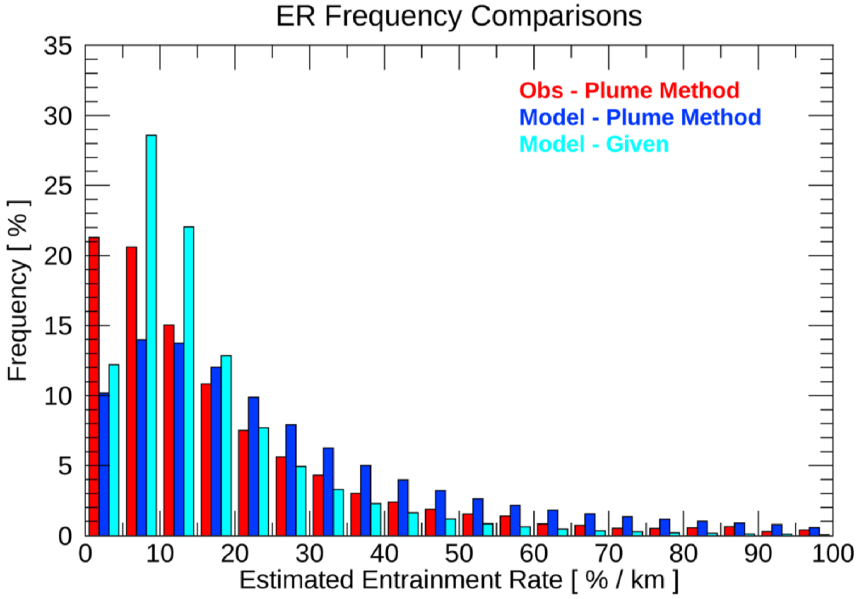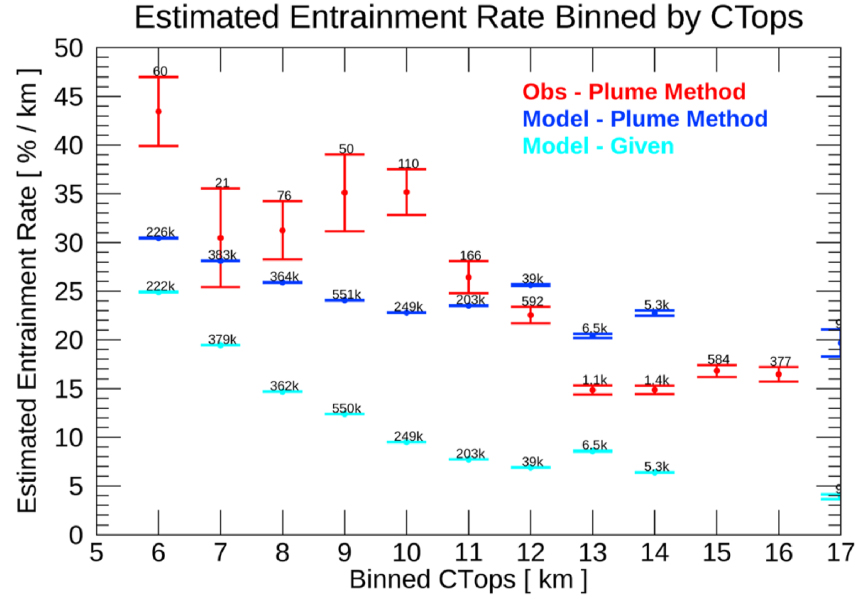Using the joint retrieval of carbon monoxide (CO) from MLS and TES on the Aura satellite, in conjunction with CloudSat/CALIPSO deep convection data, we derive deep convective λ over the globe and compare the results with GEOS-5 model counterparts. We find ~75% of λ’s are less than 20% km–1, and λ’s decrease with increasing cloud top height (see figure). The Aura CO-based λ’s also have a weak decreasing trend with increasing Convectively Available Potential Energy (not shown) and relative humidity from AIRS, whereas the GEOS-5 λ’s exhibit somewhat different relationships.
This study provides the first global tracer-based estimates of deep convective λ. The results serve as important reference for improving convective parameterizations in climate models and constraining model simulations of deep convection.

The observational entrainment rate is derived using Aura CO and a plume model. Two GEOS-5 entrainment rates are shown. One is based on GEOS-5 simulated CO profiles and the plume method. The other is directly from the convective parameterization scheme. The comparison between the observational estimates and the model results are for deep convective events in 2009.

Observed cloud top height is from CloudSat/CALIPSO data. The modeled cloud top height is taken as the level of maximum detrainment mass flux from the convective parameterization scheme.
Frequency distribution (top) of entrainment rate (λ) estimates and (bottom) the relationship of λ with cloud top heights (CTops). The λ estimates are from Aura TES/MLS CO profiles (red), from GEOS-5 simulated CO profiles (blue), and directly from GEOS-5 (cyan). All three estimates show larger occurrence frequency when λ < 20% km–1, and show λ decreasing with increasing cloud top height. The CO-based λ estimates are higher than the direct GEOS-5 estimates because the former represent the bulk entrainment over an area of ~300 km across and the latter correspond to entrainment at cloud scale.
Scientific significance, societal relevance, and relationships to future missions:
Convective entrainment rate is the most sensitive parameter that contributes to the uncertainty in climate sensitivity and simulations of clouds, precipitation, and distributions of trace gases. CO is a well conserved tracer in convective transport and the MLS/TES joint retrieval of CO profile enables an observational estimate of entrainment rate for global convective events. The relations of entrainment rate with cloud top height, CAPE and RH are critical for developing new entrainment parameterizations in GEOS model and serve as useful references for other climate models. Currently, new entrainment parameterization schemes are being tested at GMAO and observations from Aura and other satellites are playing an important role in guiding these model improvements.
Aura’s TES instrument is no longer operating, although CO observations from AIRS on Aqua or CRIS on NPP/JPSS-1 could potentially provide replacement information. No missions are planned, from any agency, to continue the high-vertical-resolution MLS CO observations in the upper troposphere, where much of the deep convective outflow occurs.
Data sources:
Aura CO data are from the joint MLS and TES retrieval products, which are available at https://mls.jpl.nasa.gov and http://tes.jpl.nasa.gov. Version 4 CloudSat/CALIPSO 2B-CLDCLASS-LIDAR is used to identify deep convective events. Version 6 of AIRS Level 2 AIRX2RET temperature and water vapor data are used to compute CAPE and relative humidity (RH). GEOS-5 model simulations are available upon request.
References:
Contact : Hui Su, Jet Propulsion Laboratory, California Institute of Technology
Citation: Stanfield, R. E., H. Su, J. H. Jiang, S. R. Freitas, A. M. Molod, Z. J. Luo, L. Huang, M. Luo, Convective entrainment rates estimated from Aura CO and CloudSat/CALIPSO observations and comparison with GEOS-5, J. Geophys. Res. 10.1029/2019JD030846, 2019.
This work was supported by NASA ACMAP-AST program, Aura MLS and CloudSat projects (managed by Ken Jucks and Richard Eckman)
11.2019